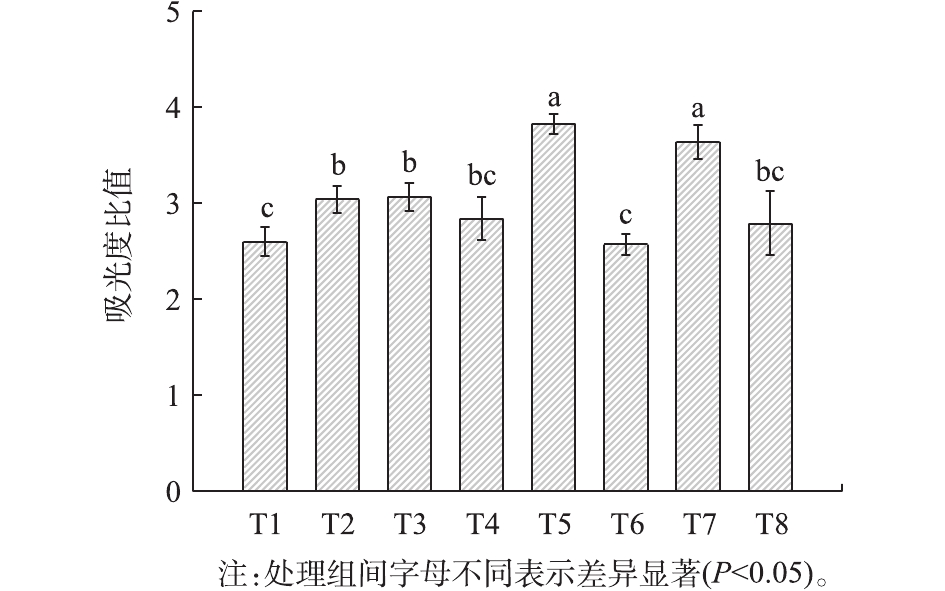-
随着城市化进程的加快,城市绿化也因其在提高城市环境质量、维持城市生态平衡等方面的重要作用得以迅速发展。我国城市园林绿化产生的落叶、剪草、枯枝等绿色废弃物,年产量已增加到3.5×108 t左右[1]。堆肥化处理由于可以将废弃物转化为对植物生长和土壤改良有促进效果的堆肥产品,已成为高效处理并实现废弃物再利用的重要途径。绿化废弃物含有丰富的有机物质,这一特点使其腐熟后更容易获得高养分的肥料;但另一方面,绿化废弃物中大量结构紧密的木质纤维素成分使他们不易被微生物分解[2],而且处理不当会造成腐熟缓慢,产生气味污染以及堆肥产品降解不完全等问题。
由于堆肥是以微生物为主导的有机废弃物降解过程,因此,可以通过添加微生物菌剂来加快木质纤维素降解。杭怡琼等[3]研究发现,白腐真菌能够有效且有选择性地降解植物纤维原料中的木质素。黄丹莲[4]发现,木霉菌等真菌不仅能分泌胞外酶,还可以利用菌丝穿插破坏纤维素结构,实现对纤维素的高效分解。此外,纤维素酶作为一种可以促进木质纤维素糖化的酶制剂,在动物饲料和纸浆生产等领域已被广泛应用[5-6]并显示出良好的降解效果,但是在堆肥领域却鲜有关于纤维素酶的应用研究。同时,有研究[2,7-9]表明,适宜的粒径可以提高堆肥期间的微生物活性,从而加快大分子物质的降解速度。过大的粒径会导致通风过度,热量散失;过小的粒径会使持水量过高,通氧量不足,这些都不利于微生物进行代谢活动。已有研究[10]提出的最佳堆肥粒径为5~30 mm,没有统一的标准;而且大部分研究[11-12]缺少对微生物指标的分析或是采用传统的DGGE技术进行微生物检测,无法准确地反映粒径与微生物群落结构和堆肥腐熟效果的关系。因此,初始粒径对绿化废弃物堆肥的影响仍需进一步研究,这也影响着外源添加剂的作用效果。
本研究采用由白腐真菌和木霉菌组成的微生物菌剂,结合纤维素酶制成外源添加剂,进行不同粒径的绿化废弃物堆肥,通过分析堆肥的理化性质和细菌群落结构,探究不同初始粒径和外源添加剂对绿化废弃物堆肥腐熟度的促进效果,并提出最优参数组合,为提高绿化废弃物堆肥质量提供参考。
全文HTML
-
实验材料:作为堆肥原材料的绿化废弃物主要来自于北京市城市景观维护过程中产生的枯枝落叶和修剪的枝条(多为柳树、槐树、杨树等),分别粉碎至2 mm和5 mm;微生物菌剂包括木霉菌和白腐真菌,推荐接种量为3%~5%;纤维素酶的酶活为3.33×105 nmol·(s·g)−1;干羊粪用于调整原料的C/N至28左右;发芽实验选择白菜种子进行。供试材料和堆肥初始性质如表1所示。
实验仪器:恒温培养箱(RXZ-500A,宁波江南仪器有限公司);精密pH/EC仪(MP522,上海精密科学仪器有限公司);TOC分析仪(TOC-5000A,日本岛津公司);紫外可见分光光度计(TU-1810DS,北京普析通用仪器有限责任公司)。
-
实验共有8个处理(T1~T8) (表2),设计2 mm和5 mm 2种粒径,纤维素酶和菌剂的接种量分别设置为物料干质量的0、2%和0、2%、4%,按表2所示的比例混配后作为外源添加剂。所有处理重复3次。每个处理按设计参数混配1 000 g(干质量)混合物,放入塑料长方体(35 cm×22 cm×10 cm)发酵容器中,添加蒸馏水,将每个处理的水分含量统一调节至65%,最后将发酵容器密封,并置于恒温培养箱中,于50 ℃下发酵22 d。每3 d进行翻堆和补水,以保证每个容器中的堆肥有适宜的氧气和水分。堆肥结束后,于每个处理的顶部、中部和底部共取样200 g,混合均匀。一部分样品作风干处理用于有机碳、全氮、pH、电导率(EC)和腐殖指标的测定;剩余新鲜样品与去离子水按1∶10 (g∶mL)混合,振荡2 h浸提后过滤,在25 ℃恒温的培养箱内培养白菜种子,放置48 h后,取出记录发芽种子个数和根长,计算发芽指数[13]。实验第2天、12天、22天,对T1~T8实验组取样进行细菌高通量分析,分别标注为T1D2~T8D2、T1D12~T8D12和T1D22~T8D22,代表初期堆肥、中期堆肥和末期堆肥。
-
有机碳、全氮、pH和EC值参照文献中的方法[14]测定:有机碳采用外加热法测定;全氮采用凯氏定氮法测定;使用pH/EC仪测定pH和EC值。微生物指标参照MAO等[15]的方法测定,并在门水平注释其群落的物种信息。根据鲍士旦[16]的方法提取腐殖质和胡敏酸,提取液使用TOC分析仪分别测定得腐殖质和胡敏酸含量[17];腐殖质提取液采用紫外可见分光光度计测定吸光度比值(E4/E6)[14]。
腐殖质系数[12]按式(1)计算,发芽指数[18]按式(2)计算。
式中:FHI为腐殖质系数;CHA为胡敏酸含量,g·kg−1,CT为总有机碳含量,g·kg−1;FGI为发芽指数;ST为处理组平均发芽数量;LT为处理组平均根长,mm;SC为对照组平均发芽数量;LC为对照组平均根长,mm。
使用CANOCO 5软件进行RDA分析,采用SPSS 23软件进行方差分析和主成分提取,依据参考文献中的方法[19]进行主成分分析。
1.1. 实验材料和仪器
1.2. 实验设计和取样
1.3. 检测和分析方法
-
在堆肥过程中,微生物不断分解利用有机物质进行繁殖和代谢,作为其主要能量来源的碳素以远大于氮素的速度被消耗,C/N整体呈下降趋势,与堆肥产品的腐熟程度密切相关。由图1可知,堆肥结束后,除对照组T1外的所有处理C/N均低于20,满足腐熟要求[20]。各处理C/N降幅排序为T3>T7>T4>T2>T8>T1>T6>T5。2 mm粒径组平均降幅较5 mm处理组提高12.7%,说明2 mm粒径更有利于有机质降解活动的进行;同时,添加纤维素酶和菌剂的处理T3和T7在各自粒径组中降幅最大,这是因为菌剂可以直接扩大微生物数量;另外,纤维素酶可以有针对性地提高纤维素的水解效率,生成更利于被微生物分解的单糖[21],进而提高微生物活性,在二者共同作用下,对促进腐熟起到协同效果。
-
pH与堆肥微生物的活性关系密切。有研究[22-23]表明,pH为7~8.5时,堆肥常见微生物的活性和繁殖力最强。如图2所示,堆肥结束后,所有处理的pH值均处于弱碱性范围,从大到小顺序为T1>T5>T4>T2>T3>T8>T7>T6,2种粒径组对照处理的pH均高于同组其他处理。这说明添加剂对降低pH有一定影响。原因是,当有机化合物被分解时,具有外源添加剂的处理可促使微生物生成有机酸[24]。从粒径对pH的影响来看,2 mm处理组pH更高。这可能是由于2 mm处理的绿化废弃物在堆肥过程中,有利于能促进有机酸分解的微生物的生长,从而影响了发酵环境酸碱度。
EC反映了堆肥产品中总盐的含量,可用作有机物分解动力学的判定指标[15]。在本研究中,堆肥末期各处理的EC值排序依次为T5>T2>T4>T7>T1>T3>T8>T6,2 mm粒径组的平均EC较5 mm粒径组高8.6%。这表明具有较小粒径的堆肥含有较多的盐和小分子物质[25]。造成这一结果的原因可能是小粒径堆肥的比表面积较高,从而增加了其离子交换能力[26]。
-
未腐熟堆肥中的毒性物质会抑制植物的生长,因此,堆肥浸提液对植物生长的影响可用于评价堆肥的植物毒性,用发芽指数[27](GI)表示。图3显示,GI值从大到小依次为T3>T8>T4>T6>T5>T7>T2>T1,所有堆肥的GI均大于60%,高于腐熟标准要求的50%的阈值[28]。在2 mm粒径处理中,具有外源添加剂的处理组GI值较对照组增加了15%~36%;在5 mm粒径处理中,增加了2%~16%。这表明纤维素酶和菌剂的添加对有机毒物的降解产生了积极影响,能有效改善GI,2 mm粒径更有利于增强添加剂的作用效果。
-
腐殖酸在波长465 nm和665 nm处具有特异吸收峰值。在堆肥过程中,2个波长处的吸光度比值(E4/E6)随着腐殖酸分子缩合度的增大而减小[29],成为评价堆肥结构稳定性的重要参数之一。如图4所示,堆肥结束时,各处理堆肥的E4/E6排序为T5>T7>T3>T2>T4>T8>T1>T6,在5 mm处理组中获得相对较高的E4/E6比值,较2 mm组高11.1%。这说明2 mm处理可使堆肥中的腐殖酸有更高的聚合度和稳定性,品质更佳。
-
堆肥是大分子碳水化合物通过微生物转化为腐殖质的过程。图5显示,堆肥末期,2 mm处理的腐殖质和胡敏酸的平均含量分别比5 mm处理高17.9%和3.7%。这可能是由于小粒径处理中的纤维素材料更容易被分解,为氧化和芳香结构的形成提供了丰富的底物。在相同的粒度组中,对照组的腐殖质和胡敏酸含量最小,这归因于添加纤维素酶和菌剂能增加相关功能菌的数量,促进腐殖质的形成。除了腐殖质含量的变化,腐殖化系数(HI)被认为可以更准确地反映腐殖化程度[30]。在堆肥过程中,腐殖化系数呈上升趋势,分子质量较低的富里酸在矿化过程中降解,并浓缩成结构更复杂的大分子胡敏酸,使腐殖质更加稳定。在堆肥结束时,腐殖化系数排序为T4>T3>T8>T6>T2>T7>T1>T5,纤维素酶和菌剂对腐殖化系数有显著影响(P=0.001<0.05),说明二者的添加对提高堆肥腐熟程度有重要作用。
-
堆肥理化指标的分析表明,2 mm粒径和外源添加剂处理组对改善堆肥理化性质有积极作用。为了从微生物角度解释粒径和添加剂对理化性质的影响,对粒径和添加剂对微生物群落组成以及特定功能微生物的影响进行了分析。好氧堆肥中的细菌被公认是堆腐基质中数量最大、分布最广泛的微生物类群,不仅分解单糖效率高,也兼具了真菌和放线菌分解木质纤维素的能力[31]。图6反映了细菌群落结构与RDA分析结果。由图6(a)可知,整个堆肥过程的优势菌门的排序为厚壁菌门(Firmicutes)>绿弯菌门(Chloroflexi)>变形菌门(Proteobacteria)>放线菌门(Actinobacteria)>芽单胞菌门(Gemmatimonadetes)。堆肥初期,能有效地利用碳水化合物的厚壁菌门是优势菌种,平均丰度高达87.8%;堆肥中期,随着碳水化合物的减少,厚壁菌门丰度下降,变形菌门丰度增加至23.4%;堆肥末期,绿弯菌门平均丰度迅速增加到52.5%,放线菌门和芽单胞菌门也成为主要菌种。在堆肥过程中,具有降解纤维素功能的放线菌[32]的相对丰度持续上升,各个处理放线菌的增长比例排序为T3>T4>T8>T1>T2>T7>T5>T6,2 mm处理是5 mm处理的3.15倍。可见,2 mm更适合具有分解纤维素能力的细菌生长繁殖。在同粒径组中,只添加菌剂的处理表现不佳。其原因可能是,外源菌的介入对原生菌群的演替有一定影响,而同时具有纤维素酶和菌剂的外源添加剂处理与对照处理相比,放线菌数量有明显提升。这说明纤维素酶对降解功能菌的繁殖代谢有积极作用,从而有效优化堆肥性质。
为进一步研究细菌群落组成与理化性质之间的关系,对堆肥理化性质与堆肥样品的主要菌门进行了RDA分析(图6(b))。结果显示,C/N、pH、GI和胡敏酸与细菌群落呈显著相关(P<0.05)。C/N和pH分别与厚壁菌门和变形菌门呈正相关,发芽指数和胡敏酸与成熟阶段的主要细菌活性相关。通过分析不同堆肥时期的主导菌群发现,在堆肥初期和中期,与5 mm相比,2 mm处理组中主导菌群(厚壁菌门和变形菌门)数量更多。这表明2 mm粒径能为这些微生物提供更适合生长繁殖的环境,加快堆肥进程。在腐熟阶段,2个粒径组与能促进腐殖化的末期主导细菌(放线菌门、芽单胞菌门)[28]的相关性分别为T3>T4>T2>T1和T7>T8>T5>T6。在同粒径组中,同时添加纤维素酶和菌剂的处理与腐殖功能菌相关性更大,对其生长繁殖有积极作用,从而提高了GI、腐殖质和胡敏酸含量。这说明添加纤维素酶和菌剂能促进堆肥后期熟化,与腐殖化分析所得结论一致。因此,粒径和添加剂可以通过影响细菌群落来优化理化性质,2 mm处理组和同时具有纤维素酶与菌剂的处理组能有效促进相关功能菌增长,改善堆肥质量。
-
为避免单个指标评价的偏差和片面性,本研究采用主成分分析法,综合8项理化指标对所有处理进行综合量化评价,以更全面客观地评估不同处理的堆肥质量。分析共提取3个主成分,方差贡献率累计达85.676%,满足大于85%的要求[19]。主成分提取结果见表3,各处理的主成分综合评分见表4。
由表4可知,所有处理从优至劣依次是T3>T8>T4>T2>T6>T7>T5>T1,表现最好的是处理T3,即2 mm粒径添加由2%纤维素酶和2%菌剂组成的外源添加剂,综合分数为1.178分;表现最差的是2 mm粒径不加外源添加剂的处理T1,综合分数为−1.174分。2 mm粒径组平均得分高于5 mm粒径组,2 mm粒径组内排序为T3>T4>T2>T1,5 mm粒径组内排序为T8>T6>T7>T5。2种粒径组中有外源添加剂的处理表现均好于对照处理。其中,2 mm的最优处理是T3,纤维素酶和菌剂比例为2∶2;5 mm的最优处理是T8,纤维素酶和菌剂比例为2∶4。
主成分分析结果表明,2 mm处理组的表现整体优于5 mm处理组。究其原因可能包括2个方面:一是绿化废弃物含有大量结构紧密的纤维素和半纤维素,粒径决定了酶与这些大分子物质的接触面积和降解效率,2 mm粒径处理可以增加堆料表面积,提升酶解效果和速率;二是在孔隙率、温度和湿度等方面,2 mm粒径组为微生物提供了更好的生长代谢环境。张璐[14]曾提出,适当的粒径可以提高绿化废弃物堆料的通气透水性,并减少水从表面蒸发,改善微生物活动的物理微环境。
在同样添加4%菌剂的条件下,混配纤维素酶的外源添加剂效果优于只具有菌剂的外源添加剂。具体表现在:添加2%纤维素酶的T4组和T8组较不添加纤维素酶的T2组和T6组分别高0.372分和0.557分,表明纤维素酶对促进堆肥腐熟有至关重要的作用。其原因可能是,外源酶可以补充堆料中纤维素酶数量的不足,提升胞外纤维素酶的活力;同时,针对无法直接利用纤维素的微生物,纤维素酶作为中间介质将纤维素分解成微生物易利用的单糖,能有效提高生物质的水解。
在同样添加2%纤维素酶的条件下,分别混配2%和4%的菌剂,在不同粒径条件下的堆肥效果有明显差异。在2 mm粒径组中,添加2%菌剂的T3组效果优于添加4%菌剂的T4组,而5 mm粒径条件下则刚好相反。这可能归因于2 mm较5 mm粒径条件更适合高温堆肥细菌群落,并促进具有降解纤维素能力的细菌的生长和繁殖,添加过多菌剂导致微生物数量过多,发酵过程中的微生物环境平衡被破坏,微生物活性受到抑制[33];相反,5 mm条件下接种更多菌剂可以在合理范围内增加微生物数量,促进堆肥的腐熟。这也说明粒径对添加剂的作用效果有重要影响,相似观点是ZHANG等[34]的研究,在不同堆肥粒径下,添加鼠李糖脂,堆肥性质表现出显著差异。
2.1. 初始粒径和外源添加剂对碳氮比的影响
2.2. 初始粒径和外源添加剂对pH和EC的影响
2.3. 初始粒径和外源添加剂对发芽指数的影响
2.4. 初始粒径和外源添加剂对吸光度比值的影响
2.5. 初始粒径和外源添加剂对腐殖化指标的影响
2.6. 初始粒径和外源添加剂对微生物的影响
2.7. 堆肥产品腐熟效果的综合评价
-
1) 2 mm粒径的堆肥处理较5 mm能促进C/N和E4/E6值下降,提高腐殖质含量、胡敏酸含量和腐殖化系数,从而有利于堆肥腐殖化和稳定化;外源纤维素酶和菌剂可以降低C/N,提高发芽指数和各项腐殖化指标,促进有机质降解,从而提高堆肥质量。
2)厚壁菌门、绿弯菌门、变形菌门、放线菌门和芽单胞菌门是堆肥的主要菌门。2 mm处理组和同时具有纤维素酶与菌剂的处理组能通过促进功能菌增长,优化堆肥理化性质。
3)采用主成分分析法进行综合评价可得:纤维素酶和菌剂混配的促腐效果好于单一成分的外源添加剂,2 mm粒径可以增强添加剂的作用效果;T3组(2 mm粒径添加配比为2∶2的外源添加剂)综合评分最高,是最优堆肥处理。



 DownLoad:
DownLoad:














